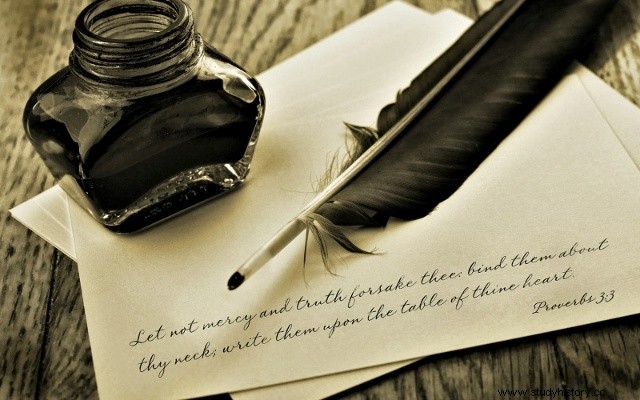
Pen and inkwell
The need to communicate and to fix one's thoughts has belonged to mankind since the dawn of civilization, an inalienable desire which, in the absence of adequate means and comfort, has been satisfied from the beginning with the help of the tools made available by nature.
Thanks to simple sharp stones , we can still admire the rock carvings bequeathed to us by primitive men, drawings and graffiti that constitute the only "written document" from very distant times, of which we can learn part of the uses and customs in force.
The first rudimentary "pen", closest to how we understand it, was the one invented by the Egyptians about 5000 years ago, a simple branch of cane chewed at the end like a brush, which was dipped in water and then rubbed on solid blocks as if it were a watercolor, while the famous Egyptian tablets were engraved with hard points after having also been softened with water.
The writing and the means to achieve it were perfected by the Greeks, who used a bone, metal or ivory stylus for engraving on wax tablets and a straw capable of retaining ink at the end to annotate words on papyri; from the latter derived the calamus dei Romani, a kind of fountain pen ante litteram consisting of a small bamboo cane engraved at one end which was dipped in a natural ink which, when pressed, allowed to write relatively easily.
The goose feather , based on the same working principle as the quill, it appeared as early as the eighth century; the central part, hollow, contained the ink, which then descended by exerting a slight pressure on the sheet.
To arrive at a more “modern” pen, we have to wait until 1884 , the year in which the American Lewis Waterman he conceived the first fountain pen , equipped with a tank that considerably increased its autonomy, avoiding continuous dipping into the ink, and a metal nib, which is easier to slide.
Finally, during the 1900s, the Hungarians Làszlò and Gyorgy Birò revolutionized the world of writing with the conception of the ballpoint pen , capable of perfectly distributing the ink on the paper thanks to a small but effective rotating metal sphere.
The resounding success of the “biro “, Mainly depended on the very long autonomy allowed, which allowed it to replace the more uncomfortable fountain pen. (Photo gives:lapiazzaweb.it and scappoinbrasile.com)

Fountain pen
